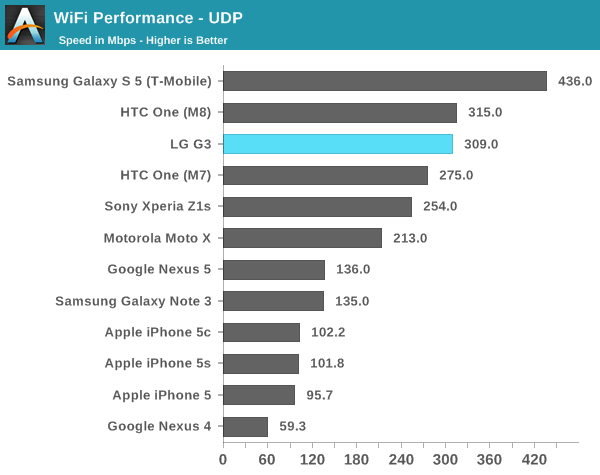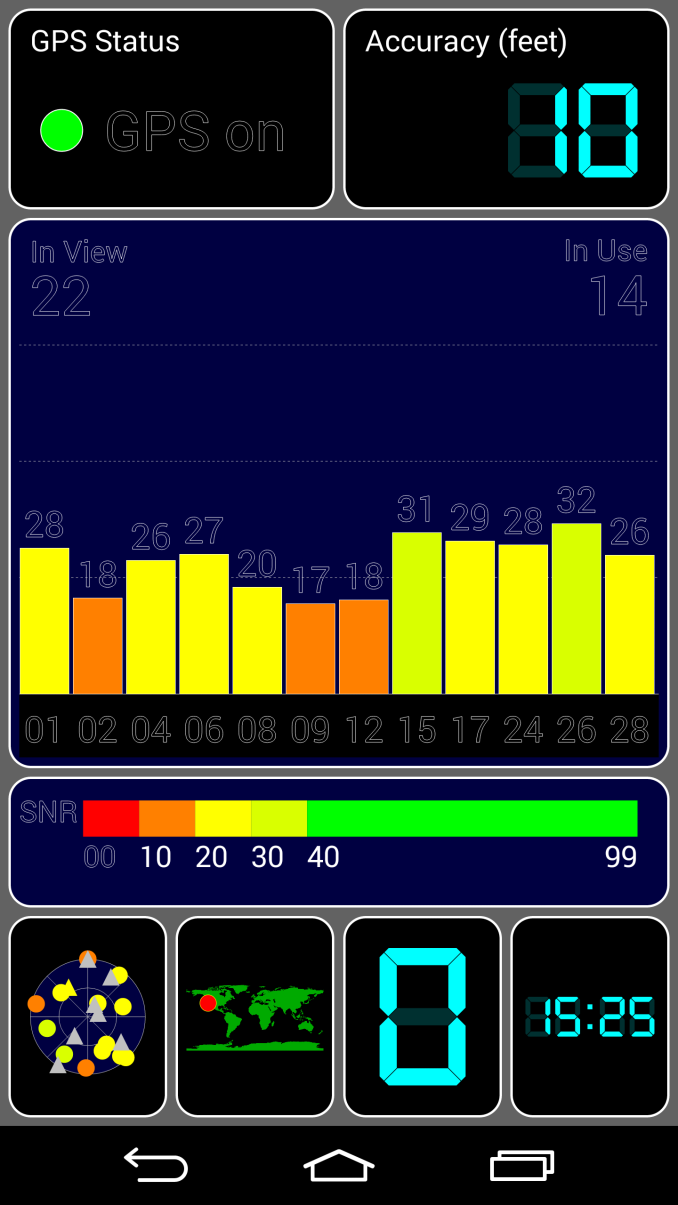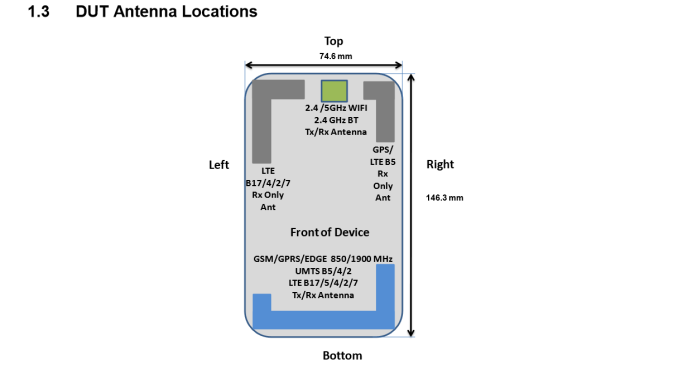The LG G3 Review
by Joshua Ho & Anand Lal Shimpi on July 4, 2014 5:00 AM EST- Posted in
- Smartphones
- LG
- Mobile
- Laptops
- G3
WiFi
These days, most OEMs seem to be using either Qualcomm's WCN3680 or Broadcom's BCM4354, depending upon whether the OEM wants to use a 1x1 or 2x2 antenna configuration. Surprisingly, LG bucks this trend by using Broadcom's BCM4339, a combo WiFi/BT/FM chip that we first saw in smartphones such as the Note 3 and Nexus 5. The WiFi antenna in this case seems to be along the top edge of the phone. It seems that LG has done some work to improve performance on this platform, as we see near parity with the One (M8)'s WCN3680 setup when the Nexus 5 and Note 3 were noticeably worse in performance. I suspect that LG selected this part with the specific goal of maintaining commonality and driving down cost by increasing volume. In this case, there doesn't seem to be any real disadvantage, especially because going to 2x2 hasn't quite doubled transfer speeds in practice.

GNSS
While GNSS quality was once a significant issue in the age of the Galaxy S and HTC Desire, today things couldn't be further from the truth. Almost every smartphone uses the MDM9x25 IP block in one way or another, and this means that GPSOne Gen8B is included as well for GLONASS, GPS, and Beidou support. Overall, accuracy is strong and the time to first lock is extremely fast, even without assistance data. On a cloudy day in San Jose it took around 30 seconds to do a true cold lock without assistance data.
Cellular
For the most part, there's not much new here as this cellular architecture is shared by the One (M8) and Galaxy S5. Namely, the G3 has an MDM9x25 modem, a WTR1625L and WFR1620 transceiver for carrier aggregation, and an Avago power amplifier for the antenna. I didn't notice much in the way of issues with cellular reception or anything else on the G3, although it seems that the SKT variant we were sampled doesn't read AT&T USSD codes correctly. This should be resolved by buying the correct regional variant. The photo below shows general antenna placement for the variants that I've seen, but banding will differ.
Rear Speaker
Unfortunately, I don't yet have the necessary equipment to test speakerphone volume on devices, but subjectively LG has put a solid speaker into the G3. It's still rear-facing, but both volume and quality are good enough to be comparable to the M8. Curiously, rather than an NXP speaker protection IC, LG has gone for a Cirrus Logic solution that identifies itself as the CS35L32. Based upon a quick search on the internet, this appears to be an obsolete part, with not much else in the way of available information.
Misc
While I'm unable to test the wireless charging functionality, I've found that the LG G3 uses IDT's IDTP9025A Qi receiver with support of the Qi 1.1 spec, which improves sensitivity to foreign objects that could heat up the phone. The NXP PN547 NFC chip in the G3 also supports host card emulation, so Google Wallet tap and pay transactions should work without issue. There's also a Maxim MAX17048 fuel gauge in the phone, which means that no battery calibration routine is required, with automatic self-correction of errors in battery charge level. It's also a bit interesting to see that a TI BQ24296 charger chip is used instead of a Qualcomm solution, which means that the Quick Charge protocol isn't supported. It seems that signalling is done via BC 1.2. The G3 uses Qualcomm's Fluence noise cancellation technology for phone calls.












174 Comments
View All Comments
Midwayman - Friday, July 11, 2014 - link
By the time VR on your phone is a 'thing' you'll have been through a couple more phones most likely.soldier4343 - Thursday, July 17, 2014 - link
So on your book we should stick with 1080p forever...Tyler_Durden_83 - Friday, July 4, 2014 - link
MSM8974AC 2.45 GHz Snapdragon 400I don't think that you meant 400 :)
JoshHo - Friday, July 4, 2014 - link
Whoops. Fixed, it should be correct now.dyc4ha - Friday, July 4, 2014 - link
Do you mean Snapdragon 801 in the table?JoshHo - Friday, July 4, 2014 - link
Yes. I distinctly recall fixing this same exact typo too. Not sure what happened there.editorsorgtfo - Friday, July 4, 2014 - link
IMO the stacked-battery issue is a red herring. Removable batteries haven't hurt Samsung's battery life versus their competition, and a stacked battery didn't break any runtime records for the Moto X. (OTOH, 720p didn't seem to help the Moto X's runtime either, which is odd considering how 1440p hurt the G3 here.)JoshHo - Friday, July 4, 2014 - link
The stacked battery design does increase volumetric efficiency. The LG G2 and Galaxy S5 are about the same size in the hand, yet the G2 has a noticeably larger battery. The Moto X is another discussion entirely as it was on a much less power efficient process and the AMOLED technology in the Moto X had much higher power draw than the LCDs available at the time.SleepyFE - Friday, July 4, 2014 - link
My old phone once froze so bad i couldn't turn it off by holding the off button. Removing the battery was the only way to get it to work again. I think that's a big enough deal to keep the battery removable.darwinosx - Friday, July 4, 2014 - link
No that would be bad hardware and software design.